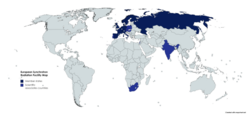
DESY, short for Deutsches Elektronen-Synchrotron, is a national research centre for fundamental science located in Hamburg and Zeuthen near Berlin in Germany. It operates particle accelerators used to investigate the structure, dynamics and function of matter, and conducts a broad spectrum of interdisciplinary scientific research in four main areas: particle and high energy physics; photon science; astroparticle physics; and the development, construction and operation of particle accelerators. Its name refers to its first project, an electron synchrotron. DESY is publicly financed by the Federal Republic of Germany and the Federal States of Hamburg and Brandenburg and is a member of the Helmholtz Association.

SLAC National Accelerator Laboratory, originally named the Stanford Linear Accelerator Center, is a federally funded research and development center in Menlo Park, California, United States. Founded in 1962, the laboratory is now sponsored by the United States Department of Energy and administrated by Stanford University. It is the site of the Stanford Linear Accelerator, a 3.2 kilometer (2-mile) linear accelerator constructed in 1966 that could accelerate electrons to energies of 50 GeV.

A synchrotron light source is a source of electromagnetic radiation (EM) usually produced by a storage ring, for scientific and technical purposes. First observed in synchrotrons, synchrotron light is now produced by storage rings and other specialized particle accelerators, typically accelerating electrons. Once the high-energy electron beam has been generated, it is directed into auxiliary components such as bending magnets and insertion devices in storage rings and free electron lasers. These supply the strong magnetic fields perpendicular to the beam that are needed to stimulate the high energy electrons to emit photons.

Diamond Light Source is the UK's national synchrotron light source science facility located at the Harwell Science and Innovation Campus in Oxfordshire.
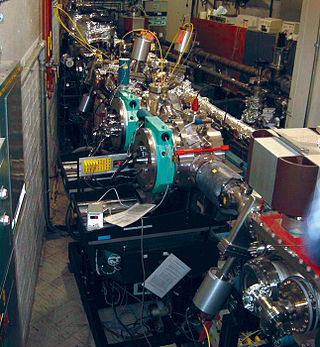
In accelerator physics, a beamline refers to the trajectory of the beam of particles, including the overall construction of the path segment along a specific path of an accelerator facility. This part is either

A synchrotron is a particular type of cyclic particle accelerator, descended from the cyclotron, in which the accelerating particle beam travels around a fixed closed-loop path. The magnetic field which bends the particle beam into its closed path increases with time during the accelerating process, being synchronized to the increasing kinetic energy of the particles. The synchrotron is one of the first accelerator concepts to enable the construction of large-scale facilities, since bending, beam focusing and acceleration can be separated into different components. The most powerful modern particle accelerators use versions of the synchrotron design. The largest synchrotron-type accelerator, also the largest particle accelerator in the world, is the 27-kilometre-circumference (17 mi) Large Hadron Collider (LHC) near Geneva, Switzerland, built in 2008 by the European Organization for Nuclear Research (CERN). It can accelerate beams of protons to an energy of 7 tera electronvolts (TeV or 1012 eV).
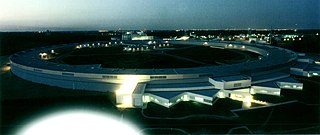
The Advanced Photon Source (APS) at Argonne National Laboratory is a storage-ring-based high-energy X-ray light source facility. It is one of five X-ray light sources owned and funded by the U.S. Department of Energy Office of Science. The APS began operation on March 26, 1995. It is operated as a user facility, meaning that it is open to the world’s scientific community, and more than 5,500 researchers make use of its resources each year.

The Canadian Light Source (CLS) is Canada's national synchrotron light source facility, located on the grounds of the University of Saskatchewan in Saskatoon, Saskatchewan, Canada. The CLS has a third-generation 2.9 GeV storage ring, and the building occupies a footprint the size of a Canadian football field. It opened in 2004 after a 30-year campaign by the Canadian scientific community to establish a synchrotron radiation facility in Canada. It has expanded both its complement of beamlines and its building in two phases since opening. As a national synchrotron facility with over 1000 individual users, it hosts scientists from all regions of Canada and around 20 other countries. Research at the CLS has ranged from viruses to superconductors to dinosaurs, and it has also been noted for its industrial science and its high school education programs.
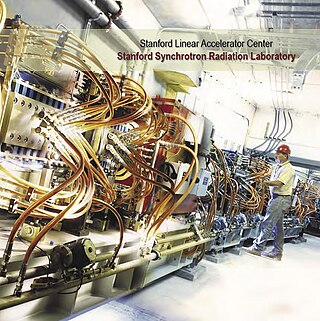
The Stanford Synchrotron Radiation Lightsource, a division of SLAC National Accelerator Laboratory, is operated by Stanford University for the Department of Energy. SSRL is a National User Facility which provides synchrotron radiation, a name given to electromagnetic radiation in the x-ray, ultraviolet, visible and infrared realms produced by electrons circulating in a storage ring at nearly the speed of light. The extremely bright light that is produced can be used to investigate various forms of matter ranging from objects of atomic and molecular size to man-made materials with unusual properties. The obtained information and knowledge is of great value to society, with impact in areas such as the environment, future technologies, health, biology, basic research, and education.

The Cornell Laboratory for Accelerator-based ScienceS and Education (CLASSE) is a particle accelerator facility located in Wilson Laboratory on the Cornell University campus in Ithaca, NY. CLASSE was formed by merging the Cornell High-Energy Synchrotron Source (CHESS) and the Laboratory for Elementary-Particle Physics (LEPP) in July 2006. Nigel Lockyer is the Director of CLASSE in spring of 2023.
The National Synchrotron Light Source (NSLS) at Brookhaven National Laboratory (BNL) in Upton, New York was a national user research facility funded by the U.S. Department of Energy (DOE). Built from 1978 through 1984, and officially shut down on September 30, 2014, the NSLS was considered a second-generation synchrotron.
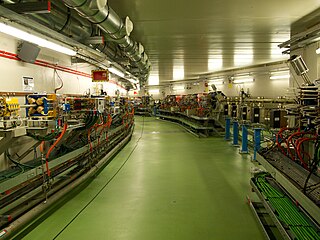
ALBA is a 3 GeV, third-generation synchrotron light source facility located in the Barcelona Synchrotron Park in Cerdanyola del Vallès near Barcelona, in Catalonia (Spain). It was constructed and is operated by CELLS, and co-financed by the Spanish central administration and regional Catalan Government.
The Australian Synchrotron is a 3 GeV national synchrotron radiation facility located in Clayton, in the south-eastern suburbs of Melbourne, Victoria. The facility opened in 2007, and is operated by the Australian Nuclear Science and Technology Organisation.

The Synchrotron-Light for Experimental Science and Applications in the Middle East (SESAME) is an independent laboratory located in Allan in the Balqa governorate of Jordan, created under the auspices of UNESCO on 30 May 2002.
The Shanghai Synchrotron Radiation Facility (SSRF) is a synchrotron-radiation light source facility in Shanghai, People's Republic of China. Located in an eighteen-hectare campus at Shanghai National Synchrotron Radiation Centre, on the Zhangjiang Hi-Tech Park in the Pudong district.

The Helmholtz-Zentrum Dresden-Rossendorf (HZDR) is a Dresden-based research laboratory. It conducts research in three of the Helmholtz Association's areas: materials, health, and energy. HZDR is a member of the Helmholtz Association of German Research Centres.
The Canadian Synchrotron Radiation Facility (CSRF) was Canada's national synchrotron facility from 1983 to 2005. Eventually consisting of three beamlines at the Synchrotron Radiation Center at the University of Wisconsin–Madison, USA, it served the Canadian synchrotron community until the opening of the Canadian Light Source in Saskatoon, Saskatchewan, finally ceasing operations in 2008.

SOLARIS is the only synchrotron in Central-Eastern Europe. Built in Poland in 2015, under the auspices of the Jagiellonian University, it is located on the Campus of the 600th Anniversary of the Jagiellonian University Revival, in the southern part of Kraków. It is the central facility of the National Synchrotron Radiation Centre SOLARIS.
Sakura Pascarelli is an Italian physicist and the scientific director at the European XFEL. Her research focuses on the study on matter at extreme conditions of pressure, temperature and magnetic fields, in particular using X-ray absorption spectroscopy (XAS) and X-ray Magnetic Linear and Circular Dichroism (XMCD).
The African Light Source (AfLS) – as of December 2022 – is the initiative to build the first Pan-African synchrotron light source. The initiative is currently led – separately – by the African Light Source (AfLS) Foundation and the Africa Synchrotron Initiative (ASI). The aim of this initiative is to establish an advanced light source on the African continent, generating intense beams of X-rays, ultraviolet, and infrared light for scientific research and innovation.

